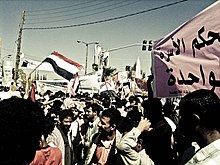
The Yemeni Armed Forces are the military forces of the Republic of Yemen. They include the Yemeni Army, Yemeni Navy and the Yemeni Air Force. The capital of the country, Sana’a is where the military is headquartered. Per the constitution of Yemen, the President of Yemen serves as the commander-in-chief.
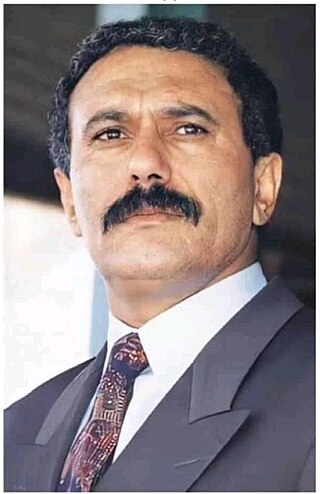
Ali Abdullah Saleh al-Ahmar was a Yemeni politician who served as the first President of the Republic of Yemen, from Yemeni unification on 22 May 1990, to his resignation on 25 February 2012, following the Yemeni Revolution. Previously, he had served as President of the Yemen Arab Republic, or North Yemen, from July 1978, to 22 May 1990, after the assassination of President Ahmad al-Ghashmi.

The General People's Congress is a political party in Yemen. It has been the de jure ruling party of Yemen since 1993, three years after unification. The party is dominated by a nationalist line, and its official ideology is Arab nationalism, seeking Arab unity. In the course of the Yemeni Civil War, the party's founder and leader Ali Abdullah Saleh was killed, while the GPC fractured into three factions backing different sides in the conflict.

The president of the Republic of Yemen is the head of state of Yemen. Under the Constitution of Yemen, the president is also the Supreme Commander of the Armed Forces and head of the executive branch of the Yemeni government.

Elections in Yemen take place within the framework of a presidential system, with both the President and House of Representatives elected by the public. Due to political instability, elections have not been held regularly since the early 2000s.

The Yemeni Socialist Party is a political party in Yemen. A successor of Yemen's National Liberation Front, it was the ruling party in South Yemen until Yemeni unification in 1990. Originally Marxist–Leninist, the party has gradually evolved into a social democratic opposition party in today's unified Yemen.

The House of Representatives is the lower house of the Parliament of Yemen. It shares the legislative power with the Shura Council, the upper house. The Assembly of Representatives has 301 members, elected for a six-year term in single-seat constituencies. It is one of the rare parliamentary chambers in the world to currently have no female representation.
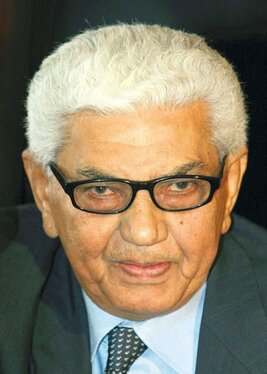
Faisal Othman Bin Shamlan was a Yemeni intellectual, technocrat, political reformist and public figure. He was a Yemeni member of parliament who had held the post of Oil and Mineral Resources Minister in the post-unification government of Yemen. Prior to the reunification of Yemen in 1990, Shamlan was the Minister of Infrastructure and Oil in the socialist government of South Yemen. He was the recognized presidential candidate of the Yemeni opposition coalition, a coalition which consists of the Islamist Islah, the Yemen Socialist Party and several smaller parties, in the 2006 presidential election, but was defeated by incumbent president Ali Abdullah Saleh.

Yemeni unification took place on May 22, 1990, when the People's Democratic Republic of Yemen was united with the Yemen Arab Republic, forming the Republic of Yemen.
The modern history of Yemen began with the withdrawal of the Ottoman Empire. In 1839 the British set up a protective area around the southern port of Aden and in 1918 the northern Kingdom of Yemen gained independence from the Ottoman Empire. North Yemen became a republic in 1962, but it was not until 1967 that the British Empire withdrew from what became South Yemen. In 1970, the southern government adopted a communist governmental system. The two countries were formally united as the Republic of Yemen on May 22, 1990.

Abdrabbuh Mansur Hadi is a Yemeni politician and former field marshal of the Yemeni Armed Forces who served as the president of Yemen from 2012 until 2022, when he stepped down and transferred executive authority to the Presidential Leadership Council, with Rashad al-Alimi as its chairman. He was the vice president to Ali Abdullah Saleh from 1994 to 2012.

The Cabinet of Yemen refers to the governing body of the internationally recognized government of the Republic of Yemen, led by its President Rashad al-Alimi, who is also the chairman of the Presidential Leadership Council (PLC), the governing body of Yemeni republic.
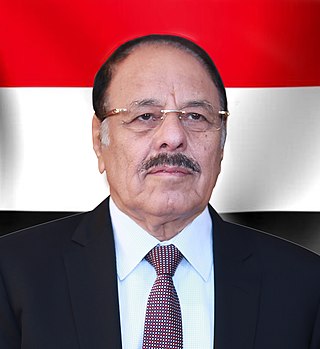
Ali Mohsen Saleh al-Ahmar, sometimes spelled Muhsin, is a Yemeni military officer who served as the vice president of Yemen from 2016 to 2022, when he was dismissed by President Abdrabbuh Mansur Hadi, who transferred the powers of the president and vice president to the Presidential Leadership Council. He is a general in the Yemeni Army and was the commander of the northwestern military district and the 1st Armoured Division. He played a leading role in the creation of the General People's Congress.
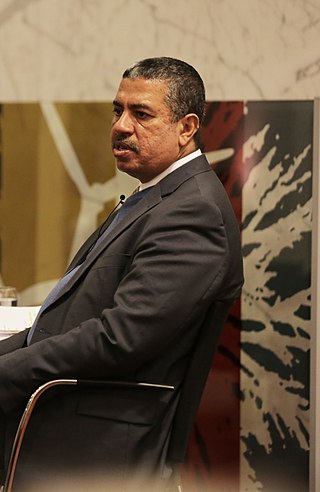
Khaled Mahfoudh Bahah is a Yemeni politician and diplomat who served as Prime Minister of Yemen between 2014 and 2016, as well as Vice President of Yemen from 2015 until he was dismissed on April 3, 2016, by President of Yemen Abdrabbuh Mansur Hadi.

Presidential elections were held in Yemen on 21 February 2012. Acting President Abdrabbuh Mansur Hadi was the only candidate, and was subsequently sworn into office on 25 February 2012. As of 2024 this is the last presidential election in Yemen, as the country descended into civil war two years later.

The Houthi takeover in Yemen, also known as the September 21 Revolution, or 2014–15 coup d'état, was a popular revolution against Yemeni President Abdrabbuh Mansur Hadi led by the Houthis and their supporters that pushed the Yemeni government from power. It had origins in Houthi-led protests that began the previous month, and escalated when the Houthis stormed the Yemeni capital Sanaa on 21 September 2014, causing the resignation of Prime Minister Mohammed Basindawa, and later the resignation of President Abdrabbuh Mansur Hadi and his ministers on 22 January 2015 after Houthi forces seized the presidential palace, residence, and key military installations, and the formation of a ruling council by Houthi militants on 6 February 2015.

The Yemeni Crisis began with the 2011–2012 revolution against President Abdullah Saleh, who had led Yemen for 33 years. After Saleh left office in early 2012 as part of a mediated agreement between the Yemeni government and opposition groups, the government led by Saleh's former vice president, Abdrabbuh Mansur Hadi, struggled to unite the fractious political landscape of the country and fend off threats both from Al-Qaeda in the Arabian Peninsula and from Houthi militants that had been waging a protracted insurgency in the north for years.
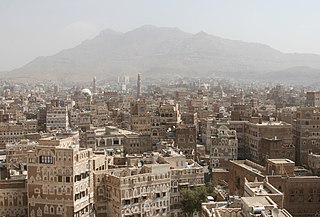
The Battle of Sanaa in 2014 marked the advance of the Houthis into Sanaa, the capital of Yemen, and heralded the beginning of the armed takeover of the government that unfolded over the following months. Fighting began on 9 September 2014, when pro-Houthi protesters under the command of Abdul-Malik al-Houthi marched on the cabinet office and were fired upon by security forces, leaving seven dead. The clashes escalated on 18 September, when 40 were killed in an armed confrontation between the Houthis led by military commander Mohammed Ali al-Houthi and supporters of the Sunni hardliner Islah Party when the Houthis tried to seize Yemen TV, and 19 September, with more than 60 killed in clashes between Houthi fighters and the military and police in northern Sanaa. By 21 September, the Houthis captured the government headquarters, marking the fall of Sanaa.

The aftermath of the Houthi takeover in Yemen refers to developments following the Houthis' takeover of the Yemeni capital of Sana'a and dissolution of the government, which eventually led to a civil war and the Saudi Arabian-led intervention in Yemen.
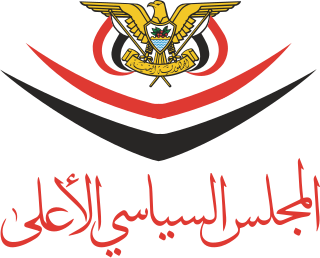
The Supreme Political Council is a largely unrecognised executive body formed by the Houthi movement and the General People's Congress (GPC) to rule Yemen. Formed on 28 July 2016, the presidential council consists of nine members and was headed by Saleh Ali al-Sammad as president until his death from a drone air strike on 19 April 2018 with Qassem Labozah as vice-president. The territory that it rules consists most of the former North Yemen, which united with South Yemen in 1990.

